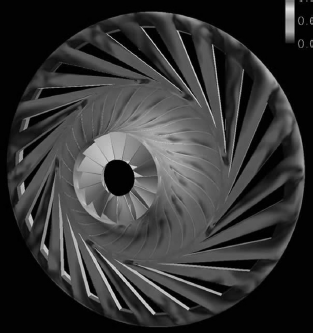CHAPTER 9Centrifugal Compressor Aerodynamics
9.1 Introduction

CFD results shown in a centrifugal compressor. Source: Courtesy of NASA
Centrifugal compressors belong to the general category of turbomachines. The flow may enter a centrifugal compressor in the axial direction. The rotor, which is known as the impeller, imparts energy to the fluid by the rotation of its aerodynamic surfaces (i.e., blades or impeller vanes) that are highly curved and twisted. The initial curvature and twist in the impeller, known as the inducer section, has the function of meeting the incoming flow at its relative flow angle. The second function of the inducer is to turn the relative flow toward the axial direction before it begins its journey in the radial direction. The third function of the inducer is to increase the fluid static pressure in the passage by decelerating the gas. The inducer exit flow is then further decelerated radially outward, by virtue of centrifugal force acting on the fluid in the spinning impeller (vaned) passages. Since the pressure rise in this type of configuration is primarily produced by centrifugal compression/force, this kind of turbomachinery is known as a centrifugal compressor. In contrast to axial-flow compressors where the flow deviation in the radial direction is negligible, the principle of operation of the centrifugal compressor is based on large radial shift ...
Get Aircraft Propulsion, 2nd Edition now with the O’Reilly learning platform.
O’Reilly members experience books, live events, courses curated by job role, and more from O’Reilly and nearly 200 top publishers.

